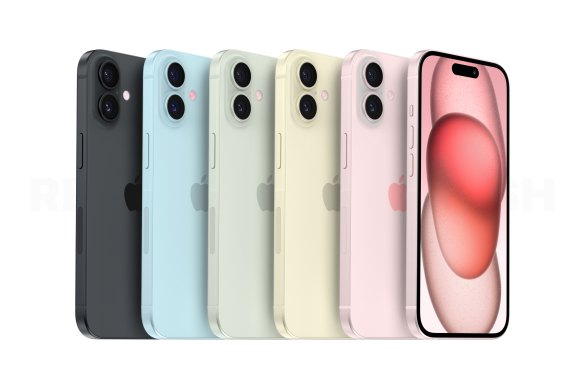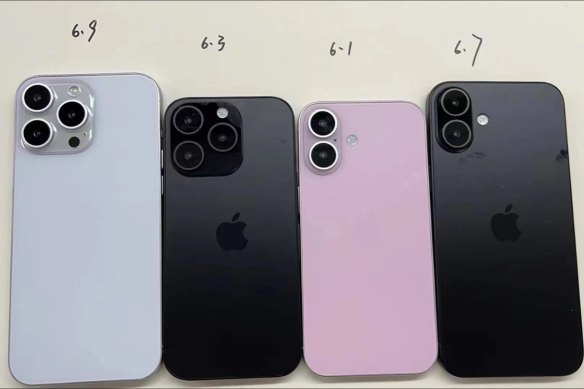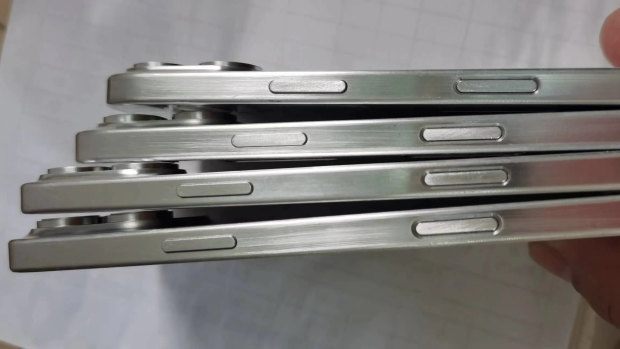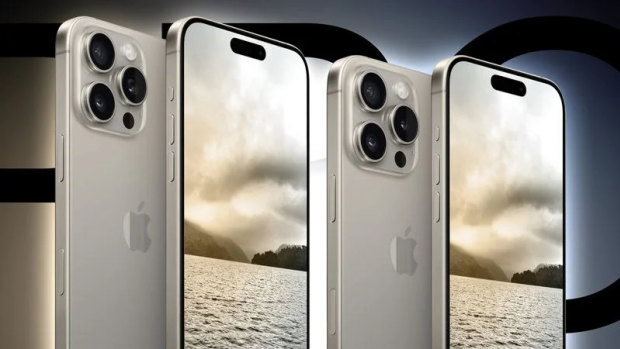This was published 10 months ago
Camera button, AI, bigger screen: Here’s what the iPhone 16 might look like
By Tim Biggs
Though we’re still around four months away from the reveal of the iPhone 16, Apple watchers have had some idea of what features the next-generation smartphone will have since before last year’s iPhone 15. And now, thanks to production ramping up, the rumours are closing in on what we may actually see in September.
Professional analysts with eyes and ears in Apple’s production hubs have been reporting on the size and shape of the screens, as well as new external and internal features. Meanwhile, like clockwork, makers of smartphone cases have obtained leaked specifications to make dummy models of the phones to test their coming wares, from which we can learn quite a bit.

This render by X-user RendersByShailesh shows what the standard iPhone 16 camera bump may look like, based on leaked specs.Credit: @shailesh__h
New sizes, more buttons
Though we can expect four iPhone models again this year, dummy models and supply chain analysts indicate Apple may break from tradition by giving each model a distinct screen size. The standard iPhone will reportedly stay at 6.1 inches (15.4 centimetres), with the Plus staying at 6.7 inches. But the Pro will move to 6.3 inches and the Pro Max to 6.9 inches.
This would mean each iPhone had a unique body size, and the largest iPhone’s display would be bigger than that of any current Samsung or Google phone, at least on paper. It would also make the largest display practically double the size of that on the original iPhone, which was 3.5 inches.

Leaker Sonny Dickson posted this image to X, purportedly showing dummies of all four iPhone 16 models.Credit: @SonnyDickson
Dummies and reports also indicate new buttons for the iPhone 16 lineup. The action button seen on last year’s Pro models – which can be programmed to activate the camera, torch, recorder, a shortcut, a focus mode or an accessibility feature – will apparently come to all iPhone 16 models. It sits on the left side of the phone above the volume keys.
On the right side, next to the power button, a new capture button will reportedly appear on all models. Several reports indicate this will be used like a camera shutter button and will have multiple steps so you can press gently to focus and press fully to capture. The Information also reports that the button will be touch-sensitive, so you can slide your finger along it to zoom, and suggests the button is to accommodate a move by creators back to horizontal orientation for videos.

This image circulating only is purported to show the new capture button on dummy iPhone 16 units.
The only other apparent physical change of note is that Apple appears to be moving the camera array on the iPhone and iPhone Plus back to a horizontal stack like on the iPhone 12, rather than a diagonal stack. It will also move other components to create a slim pill-shaped camera bump, making for the first non-square bump since 2018. The moves will put the wide and ultra-wide cameras into the same alignment on the Pro and non-Pro phones, potentially so they can equally be used to capture spatial video for Apple’s Vision Pro headset.
Internal changes
It doesn’t take leaks and rumours to guess that Apple will have a new A-series chip to power its new phones, and we can rely on our knowledge of how numbers work to assume it will be called the A18. But we can glean from leaked technical data that the company may equip all four phones with variants of the A18 this time, rather than re-using a chip for the standard and Plus models.

This render by Apple website MacRumours shows what the iPhone 16 Pro and Pro Max may look like.Credit: MacRumours
Why would it do that? Supply chain reporting out of Taiwan indicates that the A18 will have a significantly redesigned and more powerful neural processing unit, fit for complicated AI tasks.
Apple is widely tipped to be unveiling new generative AI features for iPhone as part of iOS (and we should start hearing about those next month at its Worldwide Developer Conference), and with a new chip, it may be able to do a significant amount of that on the iPhone 16 itself, whereas older devices may have to rely on cloud processing or do without. If it turns out some AI features are exclusive to the new phones, this will be why.
We don’t know a lot about the specific AI features Apple will be implementing, although there have been reports that it has struck deals with Google and OpenAI to bring large language models Gemini and GPT to the iPhone. Apple has models of its own too, and we may see them implemented in improved Siri interactions, text and image creation, or more personalised recommendations in Apple Music and Apple TV.
Other hardware rumours include standard improvements to performance, cooling, battery life, and connectivity (analyst Ming-Chi Kuo believes at least some of the iPhone 16 models will support Wi-Fi 7) and the requisite upgrade in camera capabilities.
Camera rumours are always a bit nebulous since there’s not much you can glean from something like a dummy phone or production line, but one detail some analysts seem confident about is that the 5x zoom from the iPhone 15 Pro Max will be present on the smaller iPhone 16 Pro. A separate (and older) report has the iPhone 16 Pro Max with an even bigger zoom thanks to a “super telescope” lens, but I’m not sure about that one.
The ultra-wide iPhone camera has been somewhat neglected for upgrades in recent years, but analyst Jeff Pu believes its sensor will be upgraded in resolution this year from 12 megapixels to 48, matching the standard wide camera. That standard shooter could also get an upgrade with a larger sensor, allowing for better low-light performance.
Get news and reviews on technology, gadgets and gaming in our Technology newsletter every Friday. Sign up here.